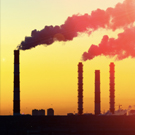Insights
 Technologies to Reduce Pollution Liability
Technologies to Reduce Pollution Liability
July 3, 2023
Industrial pollution is a significant concern as it contributes to air, water, and soil degradation. This primarily involves the release of harmful substances and waste into the environment from manufacturing or processing plants. Key pollutants include greenhouse gases, particulates, chemical wastes, and heavy metals.
Businesses around the world are seeking ways of reducing pollution while slashing the liabilities associated with pollution discharges. Here, emerging technologies are providing valuable solutions.
To learn more about pollution liability insurance solutions, visit our Environmental page.
What are the Liabilities Associated with Industrial Pollution?
The liabilities associated with industrial pollution can be significant:
- Legal Liability: Businesses that breach environmental regulations may face fines, penalties, or lawsuits. The “polluter pays” principle, widely adopted in many jurisdictions, holds that the party responsible for the pollution is accountable for covering the costs of its impacts.
- Financial Liability: The costs to clean up polluted sites, invest in cleaner technologies, or pay damages to affected parties can be substantial. Additionally, investors and customers may steer away from businesses associated with heavy pollution, affecting a company's bottom line.
- Health Liability: Industries could be held responsible for adverse health effects in the population, such as respiratory diseases, cancer, or other health issues linked to pollution exposure.
- Reputational Damage: Businesses associated with pollution may suffer from negative public perception, affecting their brand image and market position.
In the face of these liabilities, many industries are adopting cleaner production methods and exploring sustainable alternatives to minimize their environmental impact.
Emerging Technologies Used to Reduce Pollution Liabilities for Businesses
In the business world, especially for industrial companies in manufacturing, energy production, and transportation operations, technology offers robust solutions.
Several emerging technologies are showing promise in reducing pollution emissions:
- Carbon Capture and Storage (CCS): CCS technology captures carbon dioxide emissions from industrial sources like power plants and factories, transports it, and securely stores it underground to prevent it from entering the atmosphere. Some cutting-edge variants even convert captured CO2 into useful products, a process known as carbon capture and utilization (CCU).
- Renewable Energy: Solar, wind, hydro, and other renewable energy technologies are advancing rapidly and becoming more cost-competitive. Transitioning from fossil fuel energy sources to renewables significantly reduces greenhouse gas emissions.
- Energy Storage Technologies: High-capacity batteries and other energy storage technologies, like pumped hydro and thermal storage, allow for more efficient use of renewable energy by storing excess power for use when demand is high.
- Fuel Cells and Hydrogen Energy: Hydrogen fuel cells produce electricity through a chemical reaction between hydrogen and oxygen, with water as the only byproduct. Hydrogen can be produced from renewable sources, making this a clean energy technology.
- Electric Vehicles (EVs): The use of electric vehicles, both in private and public transportation, reduces emissions from fossil fuel-burning engines. As the grid becomes more renewable, the carbon footprint of EVs decreases further.
- Artificial Intelligence (AI) and IoT: AI and IoT (“Internet of Things,” or connected devices) are used to optimize industrial processes, reduce waste, and improve energy efficiency, which can significantly reduce emissions.
- Advanced Recycling Technologies: These technologies aim to improve the recycling process to reduce waste and prevent pollution. For instance, chemical recycling can convert plastic waste back into its original components.
- Bioengineering: Bioengineered organisms are being developed to consume or break down pollutants. For example, certain bacteria can consume oil spills, and fungi can absorb heavy metals.
Each of these technologies plays a crucial role in the effort to reduce pollution and transition to a more sustainable global economy. When implemented, companies can reduce the financial and health liabilities associated with pollution releases, protecting the environment and the bottom line.
Maintaining Pollution Liability Insurance
Pollution liability insurance is a specific type of insurance coverage designed to protect businesses from the costs associated with environmental contamination caused by their operations. It covers claims for bodily injury, property damage, cleanup costs, and legal defense expenses that arise from pollution incidents.
Pollution liability insurance is crucial because standard commercial liability policies typically exclude pollution-related incidents. So without specific coverage, businesses could face significant financial burdens if they’re found responsible for environmental contamination.
It is imperative that business operations maintain pollution liability coverages and to periodically review such coverages for policy gaps or decreases in liability due to the incorporation of pollution-reducing technologies like those presented above. With technology and a focus on reducing the potential for harmful pollutant emissions, industrial businesses can continue to produce without excessive impacts to the world’s delicate ecosystems. ◼

